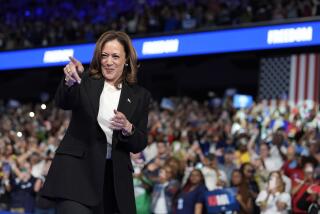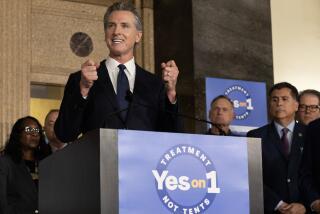Contest for California schools chief heats up

California voters haven’t booted out a state schools chief in 32 years. They’re not likely to this year, either. But don’t bet the kids’ college money on it.
This is a weird election, especially the June 3 primary. There’s nothing really compelling on the ballot. And turnout is bound to be very low.
The incumbent school master — state Supt. of Public Instruction Tom Torlakson — is not exactly a household name. Nor is he charismatic.
His major challenger — school reformer Marshall Tuck — is lecturing about the need for a shake-up in education.
Both are Democrats. But the office is officially nonpartisan.
All this sets up the potential for a repeat of 1982, when Bill Honig, a state school board member, ousted Supt. Wilson Riles, who was seeking a fourth term.
Riles, the first African American elected to statewide office in California, had himself bounced another superintendent, the showboat conservative Max Rafferty, in 1970.
Rafferty was considered a jerk. And voters thought Riles had been around too long. Honig served in office 10 years, then resigned after being convicted on conflict-of-interest charges. His felony convictions were later reduced to misdemeanors.
Torlakson, 64, is pleasant enough. A former teacher and legislator, no one has ever questioned his integrity. The rap on him is that he’s a passive tool of the powerful California Teachers Assn., which will spend millions trying to ensure his reelection.
“I’m proud to be a teacher,” he told me. “And I’m proud to have 400,000 teachers supporting me.
“I’m not flamboyant. I try to channel my energy on things that can make a big difference. I’m focused on the big picture.”
Full disclosure: My daughters are second cousins of Torlakson on their mother’s side. I haven’t been to a Torlakson family shindig in more than four decades.
When he was a lawmaker, I was impressed with some of Torlakson’s efforts, especially his trying to restore what used to be called vocational education — shop — but in recent years has acquired more bureaucratic and confusing handles like “linked learning.”
“One of my top goals is to give every student a taste of what it’s like to work,” he says. And he’s proud of last year helping to obtain $250 million for career tech, or whatever it’s being called today.
But after being elected superintendent in 2010, Torlakson seemed to become risk-averse and went into hiding. Meanwhile, a strong education reform movement was escalating all over the state.
“I work 75 to 80 hours a week,” he insists. “I’m trying to find what can make the most improvements. I’m not just going down blindalleys.”
He claims credit for helping Gov. Jerry Brown gain voter approval of a temporary tax increase that essentially ended the schools’ funding crisis. And he strongly supported Brown’s legislation last year that shifted substantial school money to classrooms with poor kids and English learners.
Torlakson — teaming with Brown — stood up to U.S. Education Secretary Arne Duncan when the Obama official threatened to withhold $1.5 billion in federal funds unless California followed his edict on pupil testing. Torlakson won, and the money kept flowing.
The superintendent — answering critics who say California schools are failing — points out that for the first time the high school graduation rate has surpassed 80%.
That’s not good enough for Tuck, however. He wants to aggressively shake things up.
Tuck, 40, is the former head of a nonprofit that oversees 15 Los Angeles schools — the creation of former Mayor Antonio Villaraigosa — and, before that, the leader of a successful charter school organization.
“We’re the wealthiest state in the nation, and our schools rank 44th in math and 45th in reading,” he told me. “We have 2. 5 million kids who can’t read and write at grade level. There’s no question that the size and diversity of California make it more difficult. But other large and diverse states are performing better.
“We’ve been stuck at the bottom for a couple of decades.”
We’re also near the bottom on spending per pupil, Torlakson points out.
Tuck blames a thick, rigid and convoluted state education code that hamstrings districts. He wants to provide local principals and teachers with much more flexibility — and empower parents by making schools more transparent.
He wants to make it easier to fire bad teachers — something the Legislature is moving toward — and to reward the best ones. The seniority system should be reformed, he says, so in an economic crunch, the young, bright teachers can be retained and the older, tired ones let go.
“The influence of the teacher unions is too large,” Tuck asserts. “Their seat at the table is too big on education policy. They don’t work for the kids.”
Tuck has been endorsed by Villaraigosa, Sacramento Mayor Kevin Johnson — a school reform advocate — and several major newspapers, including The Times.
Oh yes, there’s a third candidate on the ballot who has run unsuccessfully before: Teacher Lydia Gutierrez of Lomita. But she has virtually no campaign financing. So Torlakson and Tuck probably will advance from the primary to the November election.
Of course, this shouldn’t even be an elected job. California is only one of 11 states that elects its schools chief. That office-holder should be appointed by the governor. He already names the entire state school board, which adopts regulations that implement gubernatorial and legislative policy.
The superintendent is left with basically only a bully pulpit — which really should be better used.
More to Read
Sign up for Essential California
The most important California stories and recommendations in your inbox every morning.
You may occasionally receive promotional content from the Los Angeles Times.











